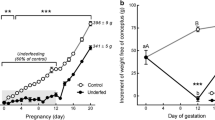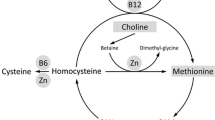Abstract
Purpose
High and low levels of selenium (Se) have been related to metabolic disorders in dams and in their offspring. Their relationship to oxidative balance and to AMP-activated protein kinase (AMPK) is some of the mechanisms proposed. The aim of this study is to acquire information about how Se is involved in metabolic programming.
Methods
Three experimental groups of dam rats were used: control (Se: 0.1 ppm), Se supplemented (Se: 0.5 ppm) and Se deficient (Se: 0.01 ppm). At the end of lactation, the pups’ metabolic profile, oxidative balance, Se levels, selenoproteins and IRS-1 hepatic expression, as well as hepatic AMPK activation were measured.
Results
The experimental groups present deep changes in Se homeostasis, selenoproteins and IRS-1 hepatic expression, oxidative balance, AMPK activation ratio and insulin levels. They do, however, have different metabolic profiles.
Conclusions
High- and low-Se diets are linked to insulin resistance, yet the mechanisms involved are completely opposite.
Graphical abstract





Similar content being viewed by others
References
Wiernsperger N, Rapin J (2010) Trace elements in glucometabolic disorders: an update. Diabetol Metab Syndr 2:70
Carreras O, Ojeda ML, Nogales F (2016) Selenium dietary supplementation and oxidative balance in alcoholism. In: Patel V (ed) Molecular aspects of alcohol and nutrition, 1 edn. Elsevier, London, pp 133–142
Day C (2007) Metabolic syndrome, or What you will: definitions and epidemiology. Diab Vasc Dis Res 4:32
Zou M, Arentson EJ, Teegarden D et al (2012) Fructose consumption during pregnancy and lactation induces fatty liver and glucose intolerance in rats. Nutr Res 32:588–598
Fowden AL, Forhead AJ (2004) Endocrine mechanisms of intrauterine programming. Reproduction 127:515–526
Nogales F, Ojeda ML, Muñoz del Valle P, Serrano A, Murillo ML, Carreras O (2017) Metabolic syndrome and selenium during gestation and lactation. Eur J Nutr 56:819–830
Ojeda ML, Nogales F, Muñoz Del Valle P, Díaz-Castro j, Murillo ML, Carreras O (2016) Metabolic syndrome and selenium in fetal programming: gender differences. Food Funct 7:3031–3038
Serrano A, Nogales F, Sobrino P, Murillo ML, Carreras O, Ojeda ML (2016) Heart selenoproteins status of metabolic syndrome-exposed pups: a potential target for attenuating cardiac damage. Mol Nutr Food Res 60:2633–2641
Zhou J, Huang K, Lei XG (2013) Selenium and diabetes—evidence from animal studies. Free Radic Biol Med 65:1548–1556
Labunskyy VM, Lee BC, Handy DE et al (2011) Both maximal expression of selenoproteins and selenoprotein deficiency can promote development of type 2 diabetes-like phenotype in mice. Antioxid Redox Signal 14:2327–2336
Wang X, Zhang W, Chen H et al (2014) High selenium impairs hepatic insulin sensitivity through opposite regulation of ROS. Toxicol Lett 224:16–23
Seale LA, Hashimoto AC, Kurokawa S et al (2012) Disruption of the selenocysteine lyase-mediated selenium recycling pathway leads to metabolic syndrome in mice. Mol Cell Biol 32:4141–4154
Reddi AS, Bollineni JS (2001) Selenium-deficient diet induces renal oxidative stress and injury via TGF-β1 in normal and diabetic rats. Kidney Int 59:1342–1353
Ozkaya M, Sahin M, Cakal E et al (2009) Selenium levels in first-degree relatives of diabetic patients. Biol Trace Elem Res 128:144–151
Stranges S, Marshall JR, Natarajan R (2007) Effects of long-term selenium supplementation on the incidence of type 2 diabetes: a randomized trial. Ann Intern Med 147:217–223
Houstis N, Rosen ED, Lander ES (2006) Reactive oxygen species have a causal role in multiple forms of insulin resistance. Nat 440:944–948
Steinbrenner H (2013) Interference of selenium and selenoproteins with the insulin-regulated carbohydrate and lipid metabolism. Free Radic Biol Med 65:1538–1547
Hardie DG (2015) AMPK: positive and negative regulation, and its role in whole-body energy homeostasis. Curr Opin Cell Biol 33:1–7
Pinto A, Juniper DT, Sanil M (2012) Supranutritional selenium induces alterations in molecular targets related to energy metabolism in skeletal muscle and visceral adipose tissue of pigs. J Inorg Biochem 114:47–54
Tajima-Shirasaki N, Ishii KA, Takayama H et al (2017) Eicosapentaenoic acid down-regulates expression of the selenoprotein P gene by inhibiting SREBP-1c protein independently of the AMP-activated protein kinase pathway in H4IIEC3 hepatocytes. J Biol Chem 292:10791–10800
Zhou X, Wang F, Yang H et al (2014) Selenium-enriched exopolysaccharides produced by Enterobacter cloacae Z0206 alleviate adipose inflammation in diabetic KKAy mice through the AMPK/SirT1 pathway. Mol Med Rep 9:683–688
Pepper MP, Vatamaniuk MZ, Yan X et al (2011) Impacts of dietary selenium deficiency on Me tabolic phenotypes of diet-restricted GPX1-overexpressing mice. Antioxid Redox Signal 14:383–390
Addinsall AB, Wright CR, Andrikopoulos S, van der Poel C, Stupka N (2018) Emerging roles of endoplasmic reticulum-resident selenoproteins in the regulation of cellular stress responses and the implications for metabolic disease. Biochem J 475:1037–1057
Ojeda ML, Nogales F, Vázquez B et al (2009) Alcohol, gestation and breastfeeding: selenium as an antioxidant therapy. Alcohol Alcohol 44:272–277
Nogales F, Ojeda ML, Fenutría M et al (2013) Role of selenium and glutathione peroxidase on development, growth, and oxidative balance in rat offspring. Reproduction 146: 659–667
Zhao H, Li K, Tang JY et al (2015) Expression of selenoprotein genes is affected by obesity of pigs fed a high-fat diet. J Nutr 145:1394–1401
Metzger BE, Buchanan TA, Coustan DR et al (2007) Summary and recommendations of the fifth international workshop-conference on gestational diabetes mellitus. Diabetes Care 30:S251–S260
Ojeda ML, Jotty K, Nogales F et al (2010) Selenium or selenium plus folic acid intake improves the detrimental effects of ethanol on pups’ Selenium balance. Food Chem Toxicol 48:3486–3491
Feoli AM, Macagnan FE, Piovesan CH (2014) Xanthine oxidase activity is associated with risk factors for cardiovascular disease and inflammatory and oxidative status markers in metabolic syndrome: effects of a single exercise session. Oxid Med Cell Longev 2014:587083
Misu H, Takamura T, Takayama H et al (2010) A liver-derived secretory protein, selenoprotein P, causes insulin resistance. Cell Metab 12:483–495
Tanti JF, Jager J (2009) Cellular mechanisms of insulin resistance: role of stress-regulated serine kinases and insulin receptor substrates (IRS) serine phosphorylation. Curr Opin Pharmacol 9:753–762
Sonntag AG, Dalle Pezze P, Shanley DP, Thedieck K (2012) A modelling-experimental approach reveals insulin receptor substrate (IRS)-dependent regulation of adenosine monosphosphate-dependent kinase (AMPK) by insulin. FEBS J 279:3314–3328
Bijland S, Mancini SJ, Salt IP (2013) Role of AMP-activated protein kinase in adipose tissue metabolism and inflammation. Clin Sci 124:491–507
Ruderman NB, Carling D, Prentki M, Cacicedo JM (2013) AMPK, insulin resistance, and the metabolic syndrome. J Clin Invest 123:2764–2772
Mistry HD, Broughton Pipkin F et al (2012) Selenium in reproductive health. Am J Obstet Gynecol 206:21–30
Hamieh A, Cartier D, Abid H et al (2017) Selenoprotein T is a novel OST subunit that regulates UPR signaling and hormone secretion. EMBO Rep 18:1935–1946
Imai H, Hirao F, Sakamoto T et al (2003) Early embryonic lethality caused by targeted disruption of the mouse PHGPx gene. Biochem Biophys Res Commun 305:278–286
Shi D, Guo S, Liao S et al (2012) Influence of selenium on hepatic mitochondrial antioxidant capacity in ducklings intoxicated with aflatoxin B1. Biol Trace Elem Res 145:325–329
He S, Guo X, Tan W et al (2016) Effect of selenium deficiency on phosphorylation of the AMPK pathway in rats. Biol Trace Elem Res 169:254–260
Yoon MS (2017) mTOR as a key regulator in maintaining skeletal muscle mass. Front Physiol 8:788
Gong T, Torres DJ, Berry MJ, Pitts MW (2018) Hypothalamic redox balance and leptin signaling—emerging role of selenoproteins. Free Radic Biol Med S0891–5849:30103–30105
Yang J, Hamid S, Cai J et al (2017) Selenium deficiency-induced thioredoxin suppression and thioredoxin knock down disbalanced insulin responsiveness in chicken cardiomyocytes through PI3K/Akt pathway inhibition. Cell Signal 38:192–200
Xu J, Wang L, Tang J et al (2017) Pancreatic atrophy caused by dietary selenium deficiency induces hypoinsulinemic hyperglycemia via global down-regulation of selenoprotein encoding genes in broilers. PLoS One 12:e0182079
Acknowledgements
Grants from Andalusian Regional Government for its support to CTS-193 research group.
Author information
Authors and Affiliations
Contributions
MLO and FN were responsible for the study concept and design. AM and FN were responsible for acquisition of animal data. MLO was responsible for data analysis and interpretation of findings. MLO drafted the manuscript. FN and OC provided critical revision of the manuscript. All authors critically reviewed content and approved final version for publication. OC was responsible to find financing for the study.
Corresponding author
Ethics declarations
Conflict of interest
On behalf of all authors, the corresponding author states that there is no conflict of interest.
Rights and permissions
About this article
Cite this article
Ojeda, M.L., Nogales, F., Membrilla, A. et al. Maternal selenium status is profoundly involved in metabolic fetal programming by modulating insulin resistance, oxidative balance and energy homeostasis. Eur J Nutr 58, 3171–3181 (2019). https://doi.org/10.1007/s00394-018-1861-4
Received:
Accepted:
Published:
Issue Date:
DOI: https://doi.org/10.1007/s00394-018-1861-4




